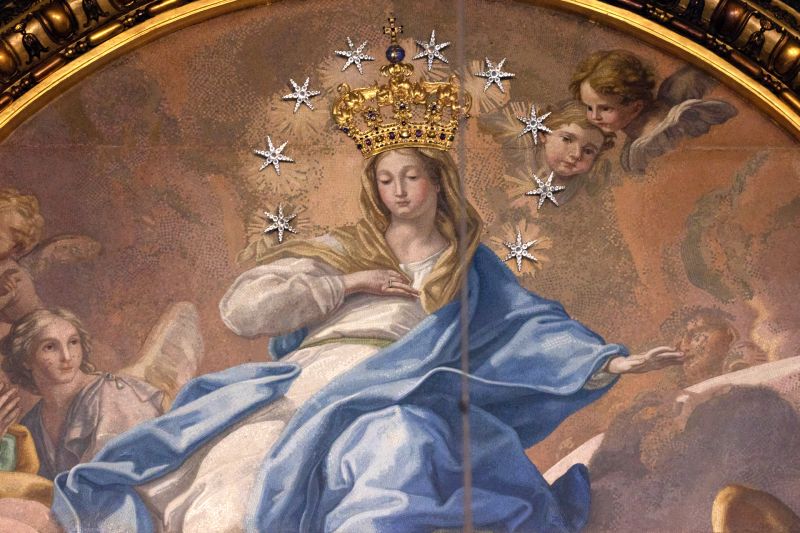
ACI Prensa Staff, Feb 7, 2024 / 10:30 am (CNA).
On Feb. 7, the Catholic Church remembers Blessed Pius IX, “Pius Nono,” the 255th pope. His pontificate is the second longest in history — a total of 31 years, seven months, and 22 days (June 16, 1846–Feb. 7, 1878). He was beatified together with Pope John XXIII (now canonized) on Sept. 3, 2000, by Pope John Paul II.
The future Pope Pius IX was born Giovanni Maria Battista Pellegrino Isidoro Mastai Ferretti in Senigallia, Italy — then part of the Papal States — on May 13, 1792. His parents were Don Gerolamo Mastai Ferretti, a member of a local noble and prestigious family, and Donna Caterina Solazzi, who had him baptized on the same day of his birth.
In 1809 he traveled to Rome to continue the studies he had begun in his native city. Even without a clear orientation toward the priesthood, he lived in an exemplary way, evidenced by some resolutions made in 1810 after a spiritual retreat when he spoke of his spiritual commitment “to fight against sin, to avoid any dangerous occasion, to study not for the ambition of knowledge but for the good of others, to abandon himself into the hands of God.”
The future pope stopped his studies in 1812 because of an illness and was exempted from military service. In 1815 he was accepted into the Pontifical Noble Guard but had to abandon the idea because of health problems. Ferretti suffered from epilepsy from a young age — a condition that eventually subsided and then completely disappeared, according to Ferretti himself, which he credited to the intercession of Our Lady of Loreto.
At the service of God and the Church
Ferretti began studies for the priesthood in 1816 and received minor orders in 1817, the subdiaconate in 1818, and the diaconate in 1819. That same year he was ordained a priest. He celebrated his first Mass in the Church of St. Anne of the Carpenters, of the Tata Giovanni Institute, of which he was appointed rector — a position he held until 1823.
Pius VII, who supported Ferretti’s early career, at first required him to have a concelebrant because of his epilepsy, but the requirement was lifted as his health improved.
Ferretti had already left clear evidence of his personality: a man of constant prayer, consecrated to the ministry of the Word and the sacrament of reconciliation, always close to the most humble and needy. He knew how to combine admirably both the active and contemplative life. Very dedicated to pastoral and social work, he was also recollected and had an intense devotion to the Eucharist and to the Virgin Mary.
In 1823 he left the Tata Giovanni Institute and traveled to Chile, accompanying the apostolic nuncio, Archbishop Giovanni Muzi. He remained there until 1825.
On his return to Italy that same year, he was appointed director of the St. Michael Home, an important ecclesial work in Rome at the service of the community, which he reformed in an effective manner. At the age of 35 he was appointed archbishop of Spoleto. This was a very hard stage of his life given his youth and inexperience, and the immense responsibility that was placed on his shoulders. During his brief time, he also contended with an abortive political revolution, using his influence to secure a pardon for the misguided revolutionaries.
In 1832, Ferretti was transferred to another diocese — this time to Imola, where he continued to be revered for his preaching, his care of his diocesan priests, clergy, and seminarians, his support of education in the diocese, and his pastoral visits to prisoners. In 1840, at the age of 48, he was named a cardinal.
Under the sign of the cross
On the afternoon of June 16, 1846, Cardinal Ferretti was elected pope and took the name Pius IX.
During his pontificate, due to the political circumstances caused by the unification of Italy — the Risorgimento — and the loss of the Papal States, his task became extremely difficult. He is said to have faced the hard times with great wisdom and prudence. For this very reason, Pope Pius IX is recognized as one of the greatest pontiffs, forced to play a political role in times of open anticlericalism encouraged by “modernist” currents.
Pius IX’s doctrinal work involved a programmatic vision aimed at addressing the main problems and threats to both the Church and Western Christian civilization: He condemned secret societies such as Freemasonry as well as fashionable ideologies like liberalism and socialism, among others. Pius IX published the “Syllabus Errorum” (“Catalogue of Errors”), in which he warned about the errors and dangers of modernism.
This made him the initiator of the development of the social doctrine of the Church. His century was marked by the Industrial Revolution and the struggle of the working class for better conditions — issues the Church would begin to address, most notably under his successor, Pope Leo XIII.
Among the most outstanding pastoral actions or measures of Pius IX’s papacy are the reestablishment of the Catholic hierarchy in England, Holland, and Scotland; the solemn definition, on Dec. 8, 1854, of the dogma of the Immaculate Conception; the sending of missionaries to the Nordic zones of America and Europe as well as to India, Burma, China, and Japan; and the celebration of the 80th centenary of the martyrdom of the apostles Peter and Paul.
Pius IX convened the First Vatican Ecumenical Council, which began in 1869 and was suspended in October 1870 after Rome fell to the forces of Italian unification. During this council, the dogma of papal infallibility was defined. That same year Pope Pius IX declared St. Joseph patron of the Church.
Back home
After the fall of Rome and the subsequent end of the “temporal power of the pope,” Pius IX locked himself in the Vatican, declaring himself a “prisoner.” His action became an example of dignity and detachment from the temporal order for his exercise of religious freedom and firmness in the face of secular power.
Upon his death on Feb. 7, 1878, Pope Pius IX’s impressive pontificate came to an end.
This story was first published by ACI Prensa, CNA’s Spanish-language news partner. It has been translated and adapted by CNA.
If you value the news and views Catholic World Report provides, please consider donating to support our efforts. Your contribution will help us continue to make CWR available to all readers worldwide for free, without a subscription. Thank you for your generosity!
Click here for more information on donating to CWR. Click here to sign up for our newsletter.






A point for renewed reflection…the condemned final and sweeping proposition in the “Syllabus or Errors” asserted that “The Roman Pontiff can, and ought to, reconcile and come to terms with progress, liberalism, and modern civilization” (n. 80).
What does it mean when some so-called backwardists in red hats observe that the end game, today, for the synodal Church is “absolute democracy”?
How to harmonize this absolute (!) with the moral absolutes of the Catechism and Veritatis Splendor? Fiducia Supplicans?
Unfortunately, he was pontiff and ruler of the Papal States during the time of Italian unification, consequently considered an opponent by a Northern Piedmontese Kingdom [Kingdom of Sardinia, Savoy, Piedmont] heavily FreeMason, and Garibaldi, himself a FreeMason, attacking from the South. Italians historically consider Pio Nono an enemy of the Risorgimento, which seems to play into the opposition to his canonization. Although he was likely aware of the FreeMasons hatred of Catholicism. The Church was persecuted, Carthusians among others, their monasteries closed by the government, churches defaced.
Aside from that turbulent history one of his worthy achievements is his definition of invincible ignorance in the encyclical Singulari Quidem [A 7] excusing ignorance beyond someone’s control. It was based on St Thomas Aquinas doctrine of knowledge beyond a person’s capacity to know (ST 1a2ae 76 2). Too many authors do not understand the exacting requirement of “beyond a person’s capacity to know”, which exceeds mere lack of knowledge as it is often cited.